Mega Man, known as Rockman in Japan, is a Japanese science fiction video game franchise created by Capcom, starring a series of robot characters each known by the moniker "Mega Man". Mega Man, released for the Nintendo Entertainment System in 1987, was the first in a series that expanded to over 50 games on multiple systems. As of December 31, 2020, the game series has sold 36 million units worldwide.

Mega Man 2 is an action game developed and published by Capcom for the Nintendo Entertainment System. It was released in Japan in 1988 and in North America and PAL regions the following years. Mega Man 2 continues Mega Man's battle against the evil Dr. Wily and his rogue robots. It introduced graphical and gameplay changes, many of which became series staples.
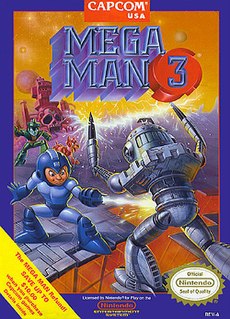
Mega Man 3 is an action-platform video game developed and published by Capcom for the Nintendo Entertainment System. It is the third game of the original Mega Man series and was originally released in Japan on September 28, 1990. The game localized in North America later in 1990 and in European regions in 1992. Taking place after the events of Mega Man 2, the plot follows the titular hero as he helps his creator, Dr. Light, and a former villain, Dr. Wily, collect parts for a peace-keeping robot by defeating several Robot Masters that have gone haywire.

Mega Man 4 is an action-platform game developed by Capcom for the Nintendo Entertainment System. It is the fourth game in the original Mega Man series and was originally released in Japan in 1991. The game was localized in North America the following January, and in Europe in 1993.
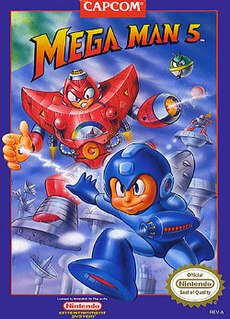
Mega Man 5 is an action-platform video game developed by Capcom for the Nintendo Entertainment System. It is the fifth game in the original Mega Man series and was released in Japan on December 4, 1992. It saw a release during the same month in North America and in 1993 in Europe.
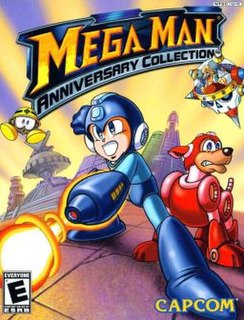
Mega Man Anniversary Collection is a compilation of video games developed by Atomic Planet Entertainment and published by Capcom. It was released in North America on June 23, 2004 for the PlayStation 2 and GameCube and on March 15, 2005 for the Xbox. The Anniversary Collection contains the first eight games in the original Mega Man series, which debuted on the Nintendo Entertainment System with the first six games, moved to the Super Nintendo Entertainment System with the seventh game, and moved to the PlayStation and Sega Saturn with the eighth game. The plot follows the robotic protagonist Mega Man in his continuing adventures battling the evil Dr. Wily and his army of Robot Masters.

Mega Man Network Transmission, known in Japan as Rockman EXE Transmission, is a video game developed by Arika and published by Capcom for the Nintendo GameCube console. The game was first released in Japan on 6 March 2003, and in North America and PAL regions the following June. The European version featured a completely different logo, which was also used on Mega Man X7, Mega Man X8, Mega Man X: Command Mission, Mega Man Zero 2, Mega Man Zero 3, Mega Man Zero 4, Mega Man Battle Chip Challenge, Mega Man Battle Network 3, Mega Man Battle Network 4, and Mega Man Battle Network 5. Network Transmission is part of the Mega Man Battle Network series, which originated on the Game Boy Advance (GBA) handheld.

Zero is a video game character present throughout Capcom's Mega Man franchise. Debuting in the Mega Man X series, Zero is an android and an elite Maverick Hunter: an organization dedicated to defending humanity from rogue Reploids, dubbed "Mavericks". Zero also acts as a mentor and longtime friend to X, the main protagonist of the X series. He continues his role as the titular main protagonist of the Mega Man Zero series. Zero has also played a supporting role in other series in the franchise such as the Mega Man ZX series and appeared in crossover video games as a guest character.

Mega Man X, known as Rockman X in Japan, with his name usually abbreviated to "X", is the main protagonist of Capcom's Mega Man X video game series originating in the 1993 Super NES video game Mega Man X. Mega Man X is an android who, along with his partner Zero, are elite members of the Maverick Hunters, a special police force tasked for defending humans and Reploids against criminal Reploids, known as Mavericks. Mega Man X has appeared in multiple printed adaptations of the series as well as an original video animation, Day of Sigma, which explores his early days as a hunter. Mega Man X is also a supporting character in the Mega Man Zero and Mega Man ZX video game series. Outside of the main Mega Man franchise, X has appeared in multiple crossover video games series.
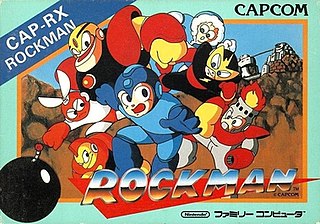
Mega Man, known as Rockman in Japan, is a 1987 action-platform video game developed and published by Capcom for the Nintendo Entertainment System (NES). It was directed by Akira Kitamura, with Nobuyuki Matsushima as lead programmer, and is the first game of the Mega Man franchise and the original video game series. Mega Man was produced by a small team specifically for the home console market, a first for Capcom, who previously focused on arcade titles.
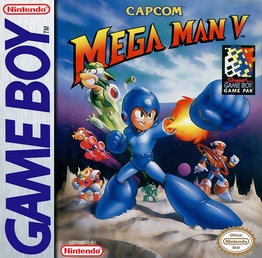
Mega Man V is a video game published by Capcom for the Game Boy handheld game console. It is the fifth game in the Game Boy version of the original Mega Man series. The game follows the adventures of the protagonist Mega Man as he must defend the Earth from a group of powerful robots from outer space called the Stardroids. Mega Man V is unique among the Game Boy Mega Man games as it features original bosses rather than recycling those from the Nintendo Entertainment System (NES) Mega Man games.

Mega Man X is an action-platform video game developed and published by Capcom for the Super Nintendo Entertainment System (SNES). It was the first Mega Man game for the 16-bit console and the first game in the Mega Man X series, a spin-off of the original Mega Man series that began on the SNES's predecessor, the Nintendo Entertainment System (NES). Mega Man X was released in Japan on December 17, 1993 and was released in both North America and Europe the following year. Taking place a century after the original Mega Man series, Mega Man X is set in a futuristic world populated by both humans and "Reploids", robots capable of thinking, feeling, and growing like their human creators. Because of these complex attributes, many Reploids are prone to destructive, renegade activity and are thereafter referred to as "Mavericks". The plot of the game follows the protagonist Mega Man X, an android member of a military task force called the "Maverick Hunters". With the help of his partner Zero, X must thwart the plans of Sigma, a powerful Maverick leader wishing to bring about human extinction.

Mega Man Battle Network is a video game developed by Capcom for the Game Boy Advance (GBA) handheld console. It is the first title of the Mega Man Battle Network series of games. It was originally released in Japan as a GBA launch game on March 21, 2001 and was released later that year in North America and Europe. It was also released via the Wii U Virtual Console in Japan on July 9, 2014, in Europe on July 24, 2014, and in North America on July 31, 2014.

Mega Man III is an action-platform video game by Capcom for the Nintendo Game Boy. It is the third game in the handheld version of the Mega Man series. The game follows the title character Mega Man as he fights the evil Dr. Wily, whose latest attempt to conquer the world involves sucking energy from the Earth's core to power a new machine. Along with foes from his past, Mega Man must contend with the next robot in Wily's line of "Mega Man Killers", Punk. Like its two consecutive predecessors on the Game Boy, the game combines elements from two previously released Nintendo Entertainment System (NES) titles: Mega Man 3 and Mega Man 4. In 2013, Mega Man III was made available on the Virtual Console of Japan's Nintendo eShop for the Nintendo 3DS. It was later released in the North American and PAL region eShops the following year.

Mega Man Soccer is a soccer video game for the Super Nintendo Entertainment System. The game is based on the original Mega Man series of action-platform games. Mega Man Soccer was released in Japan on February 17, 1994 and in North America in March of that same year.
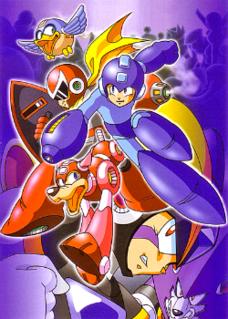
Mega Man: The Power Battle is an arcade video game and a spin-off title for the Mega Man series. It was released in Japan in 1995 and was followed by a sequel, Mega Man 2: The Power Fighters, the following year. Both games—which were the first and only arcade titles ever to exist within the Mega Man franchise—were ported to home consoles in North America in 2004 as part of the Mega Man Anniversary Collection for PlayStation 2, Nintendo GameCube and Xbox and in Japan during the same year as part of two game compilation titled Rockman Power Battle Fighters, also for the PlayStation 2. An adaptation of both games for the Neo Geo Pocket Color, titled Rockman Battle & Fighters, was also made.

Mega Man 2: The Power Fighters is an arcade video game, released in Japan in 1996 as a fighting game in the Mega Man series of games. It is the direct sequel to Mega Man: The Power Battle released the previous year. Both games were ported to home consoles in North America in 2004 as part of the Mega Man Anniversary Collection for PlayStation 2, Xbox, and GameCube and in Japan during the same year as part of two game compilation titled Rockman: Power Battle Fighters, also for the PlayStation 2. An adaptation of both games for the Neo Geo Pocket Color, titled Rockman Battle & Fighters, was also made.

Mega Man 6 is an action video game developed by Capcom for the Nintendo Entertainment System (NES). It is the sixth installment in the original Mega Man series and was originally released in Japan on November 5, 1993 and in North America the following March. It was included in the Mega Man Anniversary Collection released in 2004. Its first PAL region release was June 11, 2013 for the 3DS Virtual Console, nearly twenty years after the game's first release.
















